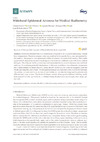Please use this identifier to cite or link to this item:
https://accedacris.ulpgc.es/jspui/handle/10553/106609
| DC Field | Value | Language |
|---|---|---|
| dc.contributor.author | León, Germán | en_US |
| dc.contributor.author | Herrán, Luis F. | en_US |
| dc.contributor.author | Mateos, Ignacio | en_US |
| dc.contributor.author | Villa, Enrique | en_US |
| dc.contributor.author | Ruiz Alzola, Juan Bautista | en_US |
| dc.date.accessioned | 2021-04-08T07:05:23Z | - |
| dc.date.available | 2021-04-08T07:05:23Z | - |
| dc.date.issued | 2020 | en_US |
| dc.identifier.issn | 1424-8220 | en_US |
| dc.identifier.uri | https://accedacris.ulpgc.es/handle/10553/106609 | - |
| dc.description.abstract | Microwave thermometry is a noninvasive and passive technique for measuring internal body temperature. Wearable compact antennas, matched to the specific body area, are required for this method. We present a new epidermal wideband antenna for medical radiometry. The double asymmetric H-shaped slot antenna was designed to be matched to di erent parts of the body without fat layers. The slots are fed by a short-circuited microstrip line in order to decrease size and back radiation, thus reducing potential interferences. In this way, contribution to radiometric temperature due to back radiation is lower than 4%, versus the 20% of the volume under investigation, over the whole operating frequency band. The designed prototype was manufactured on a flexible substrate. The antenna is a very small size, to make it comfortable and suitable for being used by patients with di erent body mass indexes. The double H-shaped antenna shows good wideband matching results from around 1.5 GHz up to 5 GHz, in di erent body locations such as the neck, foot instep and foot sole. | en_US |
| dc.language | eng | en_US |
| dc.relation.ispartof | Sensors (Switzerland) | en_US |
| dc.source | Sensors (Switzerland) [ISSN 1424-8220], n. 20 | en_US |
| dc.subject | 3314 Tecnología médica | en_US |
| dc.subject.other | Epidermal antenna | en_US |
| dc.subject.other | Flexible wideband antenna | en_US |
| dc.subject.other | Microwave medical applications | en_US |
| dc.title | Wideband Epidermal Antenna for Medical Radiometry | en_US |
| dc.type | info:eu-repo/semantics/Article | en_US |
| dc.identifier.doi | 10.3390/s20071987 | en_US |
| dc.identifier.issue | 7 | - |
| dc.investigacion | Ingeniería y Arquitectura | en_US |
| dc.type2 | Artículo | en_US |
| dc.utils.revision | Sí | en_US |
| dc.identifier.ulpgc | Sí | en_US |
| dc.contributor.buulpgc | BU-TEL | en_US |
| dc.description.sjr | 0,636 | |
| dc.description.jcr | 3,576 | |
| dc.description.sjrq | Q2 | |
| dc.description.jcrq | Q1 | |
| dc.description.scie | SCIE | |
| item.fulltext | Con texto completo | - |
| item.grantfulltext | open | - |
| crisitem.author.dept | GIR IUIBS: Patología y Tecnología médica | - |
| crisitem.author.dept | IU de Investigaciones Biomédicas y Sanitarias | - |
| crisitem.author.dept | Departamento de Señales y Comunicaciones | - |
| crisitem.author.orcid | 0000-0002-3545-2328 | - |
| crisitem.author.parentorg | IU de Investigaciones Biomédicas y Sanitarias | - |
| crisitem.author.fullName | Ruiz Alzola, Juan Bautista | - |
| Appears in Collections: | Artículos | |
WEB OF SCIENCETM
Citations
5
checked on Jun 8, 2025
Page view(s)
114
checked on Mar 30, 2024
Download(s)
41
checked on Mar 30, 2024
Google ScholarTM
Check
Altmetric
Share
Export metadata
Items in accedaCRIS are protected by copyright, with all rights reserved, unless otherwise indicated.
